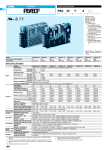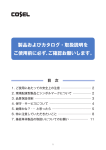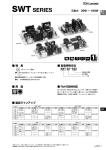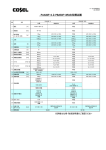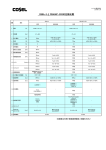Download Cosel PBA1000F Instruction manual
Transcript
Instruction Manual Unit type PBA 1 Terminal Block A-22 2 Function A-23 2.1 Input voltage range A-23 2.2 Inrush current limiting A-23 2.3 Overcurrent protection A-23 2.4 Overvoltage protection A-23 2.5 Thermal protection A-23 2.6 Output voltage adjustment A-23 2.7 Remote ON / OFF A-24 2.8 Remote sensing A-24 2.9 Alarm A-25 3 Peak Current A-25 4 Series / Parallel Operation A-25 5 6 7 4.1 Series operation A-25 4.2 Parallel operation / Master-slave operation A-26 4.3 Parallel redundancy operation A-26 Assembling and Installation Method A-27 5.1 Installation method A-27 5.2 Derating A-27 5.3 Expectancy life and warranty A-28 Others A-28 6.1 Output current monitor A-28 6.2 Isolation A-29 6.3 Auxiliary power A-29 6.4 External components (PBA1500F) A-29 Option 7.1 Option outline A-29 A-29 A-21 Unit type PBA 1 Terminal Block * This content describes PBA300F - 1500F. Please see External view about PBA50F - 150F. ¿ PBA300F å 0 9 7 8 � ����� 1 24 5 6 ¿ PBA600F å 0 �� ��� 9 7 5 6 0 9 8 7 H V.ADJ AC (L) CN1 AC (N) FG Pin No. 1 2 3 4 5 6 7 8 9 10 Pin connection and function of CN1 Function +M : +Output voltage monitoring +S : +Remote sensing -M : -Output voltage monitoring -S : -Remote sensing VB : Voltage balance CB : Current balance TRM : Adjustment of output voltage -S : -Remote sensing RC2 : Remote ON / OFF RCG : Remote ON / OFF ground Pin No. 1 2 3 4 5 6 7 8 9 10 Pin connection and function of CN2 Function +M : +Output voltage monitoring +S : +Remote sensing -M : -Output voltage monitoring -S : -Remote sensing VB : Voltage balance CB : Current balance TRM : Adjustment of output voltage -S : -Remote sensing RC2 : Remote ON / OFF RCG : Remote ON / OFF ground Pin connection and function of CN3 Pin No. Function 1 -S : -Remote sensing 2 -S : -Remote sensing 3 AUX : Auxiliary output (12V 0.1A) 4 RC1 : Remote ON / OFF 5 AUXG : AUX ground 6 N.C. : No connection 7 PG : Power good signal 8 PGG : Power good ground * The common signs in CN1, CN2 and CN3 as -S are same potential. ¿ PBA1000F å 1AC (L) 2AC (N) 3N.C. 4Frame Ground 5-Output 6+Output 7LED 8Output voltage adjustable potentiometer 9CN1 0CN2 Connector for functions åCN3 8 �� ��� �� 1 24 Instruction Manual CN2 CN3 1 2 4 5 Mating connector and terminal of CN1, CN2 and CN3 Connector Mating Connector Terminal CN1 S10B-PHDSS PHDR-10VS Reel : SPHD-002T-P0.5 CN2 Loose : BPHD-001T-P0.5 PHDR-8VS CN3 S8B-PHDSS 6 ¿ PBA1500F ��� å 0 9 8 7 ��� � � �� � � � ��� V.ADJ AC (L) AC (N) � � � ��� � ��� NC � �� � � � �� � � � � � ��� FG ��� CN3 1 2 3 4 � ��� CN1 CN2 A-22 � �� 5 6 ¿ PBA300F/600F ¿ PBA1000F / 1500F The pin No. of CN1 to CN3 Mfr. J.S.T Unit type 2 Function 2.1 Input voltage range ¡The range is from AC85 - 264V or DC(Refer to SPECIFICATIONS). Only AC input is available to comply with agency approval. ¡A low input potential can correspond more than AC85V and DC120V by the option (Refer to 7 Option). The decrease of load factor is needed, and consult us detailed. ¡If the wrong input is applied, the unit will not operate properly and / or may be damaged. Avoid the followings to cause failure of the unit to apply square wave form input voltage, which is commonly used in UPS and inverters. 2.2 Inrush current limiting ¡Inrush current limiting is built-in. ¡lf a switch on the input side is installed, it has to be the one handling the input inrush current. ¿ PBA50F, 75F, 100F, 150F ¡The thermistor is used for protection from inrush current. When power is turned ON / OFF repeatedly within a short period of time, it is necessary to have enough time for power supply to cool down. ¿ PBA300F, 600F, 1000F, 1500F ¡The thyristor technique is used for protection from inrush current. If power is turned ON / OFF repeatedly within a short period of time, that may cause failure. It is necessary to have enough time between power ON and OFF. ¡When the switch of the input is turned on, the primary inrush current and secondary inrush current are generated. Instruction Manual PBA 2.4 Overvoltage protection ¿ PBA50F, 75F, 100F, 150F, 300F ¡The overvoltage protection circuit is built-in. The AC input should be shut down if overvoltage protection is in operation. The minimum interval of AC recycling for recovery is 3 minutes. *The recovery time varies depending on input voltage. ¿ PBA600F, 1000F, 1500F ¡Overvoltage protection circuit to follow to output voltage is built-in. The AC input should be shut down if overvoltage protection is activated. The minimum interval of AC recycling for recovery is more than 3 minutes. The recovery time varies depending on input voltage. *Overvoltage protection circuit to follow to output voltage is not built into PBA300F. It corresponds by the option. Please consult us detailed. Remarks : Please avoid applying the over-rated voltage to the output terminal. Power supply may operate incorrectly or fail. In case of operating a motor etc. , please install an external diode on the output terminal to protect the unit. 2.5 Thermal protection ¿ PBA300F, 600F, 1000F, 1500F ¡Thermal protection circuit is built-in and shut down under following condition. 1When the current and the temperature which exceed from the derating curve. 2The case FAN stops or air flow is interrupted and the amount of the wind decreases. After cut off input voltage and cooling down inside of power supply, turns on the input of the power supply again. 2.3 Overcurrent protection 2.6 Output voltage adjustment ¡Overcurrent protection is built-in and activated at 105% of the rated current or 101% of the peak current. ¡Output voltage is increased by turning potentiometer clockwise and is decreased by turning potentiometer counterclockwise. Overcurrent protection protects the unit from short circuit and overcurrent condition. The unit automatically recovers when the fault condition is removed. ¡lf the output voltage drops more than 50% of the rated voltage in an overcurrent protection mode, the average current will also be reduced by the intermittent operation. ¿ PBA50F, 75F, 100F, 150F ¡A built-in potentiometer is lost, and there is an option : -V to be able to do a changeable output voltage in the potentiometer put on the outside (Refer to 7 Option). ¿ PBA1000F, 1500F ¡The output voltage is shut down when the overcurrent protection circuit operates continuously for 5 sec in PBA1000F, PBA1500F. The minimum interval of AC recycling for recovery is 3 minutes. The recovery time varies depending on input voltage and load condition. A-23 Unit type PBA ¿ PBA300F, 600F, 1000F, 1500F ��� ¡The external output voltage control function is provided. Adjustment of output voltage is possible in 110% from almost 0V of the rated output voltage by following. ¡The output voltage level is able to calculated by 1. However external voltage should not be less than -0.7V and more than 3.0V. Output voltage = 2.5 [V] ��� ��� ��� ����W ��� ���W -Applying the voltage externally between TRM and -S on CN1 or CN2 The voltage between TRM and -S Instruction Manual Xrated output voltage--1 ��� ��� �� �� �� ��� ��� ��� ����W ���W ��� ���� �� ���� � ������� ����� ������W � ��� ��� ��� ��� ���W The output voltage decrease when sourcing current from TRM. ¡When the output voltage is decreased to about 0V, the fans may stop,ripple may increase and the PG signal may turn to be ”High”. Fig.2.1 Examples of connecting ¿ PBA300F, 600F, 1000F, 1500F (It is not in PBA50F and PBA75F.) ¡Remote ON / OFF control becomes available by applying voltage in CN1. Remote ON / OFF circuit (RC2, RCG) is isolated from ¿ PBA100F, 150F input, output, FG and AUX. Table 2.1 shows the specification of remote ON / OFF. Fig.2.1 shows the example to connect remote ON / OFF control, and followings are notes when you use the remote control. 1The output stops when the current is sank in RC2. 2The current sinking RC2 is 5mA typ and less than 12mA max. 3Built-in fans stop if the output is turned off with remote ON / OFF circuit. The fans of PBA300F become low speed when the output voltage is turned off with remote ON / OFF circuit. 4The PG signal is turns to be ”High” when the output voltage is turned off with remote ON / OFF. 5In parallel operation and several use, please note a necessary voltage and current because the content of Table 2.1 description is a value at only one use. 6When the voltage or the current other than showing in Table 2.1 between RC2-RCG are applied, the output voltage might not be normally output. Table 2.1 Specifications of remote ON / OFF SW Logic Output off pin A-24 ��� ���� 2.8 Remote sensing Output on ��� remote ON / OFF ¡Option ”-R” is available for remote ON / OFF (Refer to 7 Option). Fig.2.1 (a) ��� �� ¿ PBA50F, 75F, 100F, 150F Connection method ��� ��� ����W 2.7 Remote ON / OFF ��� Fig.2.1 (b) SW open SW open (0.1mA max) (0.1mA max) ¡It corresponds by the option : -K. The correspondence model is -3R3 and -5. Please refer to 7 Option. ¿ PBA300F, 600F, 1000F, 1500F ¡Remote sensing circuit is built-in. Wiring method without using remote sensing is shown in Fig.2.2. When you do not use the remote sensing, connect between +S and +M and between -S and -M with CN1. When the power supply is shipped from a factory, a special harness (H-SN-19) is mounted on CN1. ¡Wiring method with remote sensing is shown in Fig.2.3. When you use the remote sensing, follow instruction as below. 1Note connecting wires enough because the load current flows to sensing line and an internal circuit of power supply is damaged occasionally, when defective contact of the screw such as loosening happens in the load line. 2Confirm line drop should be at 0.3V or less using a thick wire from the power supply to the load. 3Do not draw the output current from �M at CN2. 4When remote sensing is used, output voltage might become un- Fig.2.2 (c) stable because of a impedance of wiring and load condition. SW close (0.5V min) And the power supply should be evaluated enough. SW close (3mA min) SW close (3mA min) SW open (0.1mA max) RCG AUXG RCG, AUXG Following are examples to improve it. --S sensing wire is removed and terminals between -M and -S are shorted. -C1, R1 and R2 are connected as below figure. Please ask details to us. Unit type Short at CN1 (H-SN-19) +M +S -S -M C1 Load Fig.2.2 When not using remote sensing function +M +S -S -M CN1 Wire as close as possible -Ip[Rated peak current -Iave[Rated current -Duty= R1 t1 t1+t2 X100 [%] [35% [A] +V Load -V ¡Peak current can output by the following conditions. -AC170 - 264V -t1[10 [sec] R2 C1 Fig.2.3 When using remote sensing function Ip:Peak current Iave:Average current t1 2.9 Alarm t2 Fig.3.1 Peak current ¿ PBA300F, 600F, 1000F, 1500F be output. Table 2.2 Explanation of alarm Alarm Output of alarm The PG signal is "Low" when the Open collector method power supply operates correctly. Good: Low PG The signal turns to be "High" (0.5V max at 10mA) when the fan stops or the power Bad : High or Open supply stops. 50V 10mA max 0.1 F 100kW PG 4 Series / Parallel Operation 4.1 Series operation ¡Series operation is possible by connecting as shown in Fig.4.1. Output current in series connection should be lower than the lowest rated current in each unit. Power + Supply - Power + Supply - Load ¡Table 2.2 shows the alarm function built-in the power supply. Please note that the alarm signal might take several seconds and Power + Supply PGG Fig.2.4 Internal circuit of PG (a) Load -V ¿ PBA300F-24, PBA600F-24, PBA1000F-24, PBA1500F-24 / 36 (There is not setting in other models.) Load +V PBA 3 Peak Current Output current CN1 Instruction Manual Power + Supply (b) Fig.4.1 Examples of connecting in series operation ¡Notes when you use PG signal are shown below. 1The PG signal turns to be ”High” when the output voltage is turned off with remote ON / OFF. 2The PG signal may turn to be ”High” when the output current becomes 10% or less of the ratings current in parallel operation. Then, the fans, too, stop. 3The PG signal may turn to be ”High” when the output voltage is varied to about 0V and varied rapidly by external adjustment at few output current. ¡The PG signal circuit (PG, PGG) is isolated from input, output, FG, RC and AUX. A-25 Unit type PBA 4.2 Parallel operation / Master-slave operation ¿ PBA50F, 75F, 100F, 150F �� supplies, clockwise to the end. Then use the potentiometer of the mater to adjust output voltage. ¡When remote sensing is used in parallel operation, the sensing wire must be connected only to master. Terminals +S and -S of slave power supplies must be connected to master. ���� ����� � ������ � ¡Output voltage in parallel operation is adjustable by using the potentiometer of the ”master” unit. Select one power supply to be the master, and turn the potentiometer of the other, slave power ¡Parallel redundancy operation is available by connecting the units as shown below. ����� � ������ � Instruction Manual �� Fig.4.2 Example of connecting in parallel operation ¡It is impossible parallel operation with the other model. ¡The output voltage changes by about 5% in a parallel operation when one stops by the fail of input side. ¡When the output current becomes less than 10% of the rated current, the PG signal may become High and the fans may stop. ������� ������� Remarks : This product is not good at parallel operation by which the OR diode is not put because the synchronous rectification method is used. ������� ������ ������������ �� ��� �� � �� �� � �� ��� �� �� ��� ¡Values of l1 and l2 become unbalanced by a slight difference of the output voltage. Make sure that the output voltage of units is of equal value and the output current from each power supply does not exceed the rated current. l1, l2 [ the rated current value ��� ����������� �� ��� �� � �� �� � �� ��� �� �� ��� ��� ¿ PBA300F, 600F, 1000F, 1500F ¡Parallel operation is available by connecting the units as shown in Fig.4.3. ±S, VB and CB are connected mutually in parallel, and ±S and ±M are connected with CN1 of the master power supply. ������ ������� ���� ����������� �� ��� �� � �� �� � �� ��� �� �� ������� ������ ��� ��� When the power supply is shipped out of a factory, special harness (H-SN-19) mounts on CN1 of each power supply. Remove special harness (H-SN-19) mounted on CN1 of the slave Fig.4.3 Examples of connecting parallel operation (The case of PBA1500F) power supply. Please use optional harnes : H-PA-3 to connect ±S, VB and CB in parallel. As variance of output current drew from each power supply is maximum 10%, the total output current must not exceed the value determined by the following equation. (Output current at parallel operation) = (the rated current per unit) X (number of unit) X0.9 ¡When the number of units in parallel operation increases, input current increases at the same time. Adequate wiring design for input circuitry is required, such as circuit pattern, wiring and current capacity for equipment. ¡In parallel operation, the maximum operative number of units is 5. ¡Please consult us the harness for a parallel operation. ¡The wiring impedance of the load from each power supply must become even so that the output current balance circuit may operate normally. A-26 4.3 Parallel redundancy operation ¿ PBA300F, 600F, 1000F, 1500F ¡N+1 redundancy is possible for reliability. ¡The system can be operated in a normal power supply even if one of power supplies breaks down when using in parallel by power supply number +1 necessary for the system. ¡Consult us about parallel redundancy. 5 Assembling and Installation Method 5.1 Installation method ¡The screw should be inserted up to 6mm max from outside of the power supply to keep a distance between inside parts and an isolation. Instruction Manual PBA (2)Derating curve ��� ���� ������ ��� Unit type 2 �� 1 1���������� 2������ ��� ������ � ���� �� �� �� � � �������� ��� � �������� � �������� � �� �� �� ���� �� ���� �� ���� �� ���� �� ���� �� ���� �� ���� �� ���� �� ���� �� ���� �� ���� �� ���� �� ���� �� ���� �� ���� �� ���� �� ���� �� ���� ������� ������������C� ������ � � �� ���� ���� ����� ������� �� ��� ������ ������� �� �������� ������ ¡Specifications inside the hatched area, Ripple-Ripple Noise is changed. ¡Standard of cooling Please use do to become below the temperature which the temperature of Point A shows in Table 5. Point A is displayed on the- �������� ����� chassis (Refer to External view). ��� ��� Table 5 Fig.5.1 Mounting screw ¿ PBA50F, 75F, 100F, 150F ¡When two or more power supplies are used by side, position them with proper intervals to allow enough air ventilation. Ambient temperature around each power supply should not exceed the tem- PBA50F PBA75F PBA100F PBA150F ¿ PBA300F, 600F, 1000F, 1500F perature range shown in derating curve. ¿ PBA300F, 600F, 1000F, 1500F ¡Fans for forced cooling are built-in. Do not block the ventilation at suction side (terminal block side) and its opposite side. Fix firmly, considering weight, though it can be used by the installation. ¡Derating curve depending on ambient temperature is shown in Fig.5.2. In the hatched area, the specifications of Ripple and Ripple Noise are different from other, refer to specifications. [%] 100 90 ¡Install the air filter so that the effect of cooling by the fan does not decrease when the power supply is used in a dusty place. 80 Load factor 5.2 Derating ¿ PBA50F, 75F, 100F, 150F (1)Mounting method A Point A Ambient temperature:50C Ambient temperature:71C 72C or less 82C or less 83C or less 84C or less 87C or less 83C or less 89C or less 85C or less 70 60 71C 50 40 30 B C 20 10 0 - 20 - 10 0 10 20 30 40 50 60 70 80 Ambient temperature[C] Fig.5.2 Derating curve depending on Normal mounting ambient temperature A-27 Instruction Manual Unit type PBA ¡Derating curve depending on input voltage of PBA1500F is shown in Fig.5.3. ¡Warranty PBA50 - 150F : The warranty is 5 years when average ambient temperature of year is Ta=40C or less and load factor is average 50% or less. [%] However, the warranty is 3 years when average ambient tempera- at AC100V 100 ture of year is Ta=50C or less and load factor is series 100%. PBA300 - 1500F : Load The warranty is 5 years if it is derating curve. 80 6 Others 85 95 6.1 Output current monitor [AC V] ¿ PBA300F, 600F, 1000F, 1500F Fig.5.3 Derating curve depending on input voltage ¡It is possible to know the output current to measure the voltage between CB to -S in CN1 or CN2. (PBA1500F) ¡The relation between CB voltage and load current is shown in Fig.6.1. 5.3 Expectancy life and warranty ¡Expectancy life The expectancy life is as follows. [V] Load factor 50% 100% Ta=30C More than 10 years More than 10 years PBA50F 150F Ta=40C More than 10 years 6 years (Installation A) Ta=50C 5 years 3 years Ta=40C 7 years* 7 years* PBA300F 1500F Ta=50C 6 years* 5 years *It is a value to which the maintenance of the fan is required. Average ambient temperature(year) -6 Voltage of CB terminal Installation condition ¿ PBA300F, 600F, 1000F, 1500F -4 -2 0 ¡Regular exchange is necessary for the fan, because the life expectancy (R (t) =90%) of the fan depending on the use condition is shown in Fig.5.4. 100 200 Load current 300 [A] 2 Fig.6.1 Load current conversion graph(PBA1500F-5) [H] 500,000 Remarks : Life expectancy of fan Fig.6.1 is nominally, not guarantee. Please ask to us if the characteristic of the other model is necessary. 100,000 ¡Note the following when you measure the voltage of CB terminal. -Please note wiring so as not to malfunction because of the noise. -Please use the input impedance of measurement equipment must be 500kW or more. 10,000 30 -Please note internal parts might be damaged when CB terminal and -S terminal are short circuit. 40 50 60 Ambient temperature[C] Fig.5.4 Life expectancy of fan A-28 70 80 Unit type 6.2 Isolation ¡For a receiving inspection, such as Hi-Pot test, gradually increase (decrease) the voltage for start (shut down). Avoid using Hi-Pot tester with the timer because it may generate voltage a few times higher than the applied voltage, at ON / OFF of a timer. If the unit is tested on the isolation between input & output and output & FG must be shorted output, RCG, PGG and AUXG. Instruction Manual PBA 7 Option 7.1 Option outline ¡Consult us detailed option and delivery before hand. ¡It is possible a combination of the option, and consult us that it is not possible to do according to the option for the combination occasionally. 6.3 Auxiliary power (AUX) ¿ PBA300F, 600F, 1000F, 1500F ¡Auxiliary power (AUX : 12V0.1A) is possible for remote ON / OFF and its attached circuit from CN3. ¡AUX circuit (AUX, AUXG) is isolated from input, output, FG, PG and RC. ¿-C --C means internal PCB is coated. (Humidity improvement goods) ¿-E, -G -Low leakage current type. -The difference from standard is shown Table 7.1. ¡Please do not take out the current which exceeds 0.1A from AUX to avoid the breakdown of the power supply and the malfunction. Table 7.1 Low leakage type Do not exceed 0.1A on starting up when you connect the DC-DC converter with AUX. 6.4 External components (PBA1500F) ¡This power supply complies with FCC Part15 class B and EN55022-B in connecting a noise filter with the external. Example of value of external noise filter L 1 : 0.45mH L 2 : 0.45mH C1 : 0.1 F C2 : 0.1 F C4 : 4700pF C5 : 4700pF R1 : 2MW R2 : 2MW R1 C1 L1 C2 C4 ¿-U -Operation stop voltage is set at a lower value than standard version. PBA50F / 75F / 100F / 150F correspond by standard. C3 : 0.1 F Use condition Output PBA1500F L2 C3 R2 AC(L) PBA50F 15W (10W) PBA300F 125W (83W) PBA75F 35W (20W) PBA600F 250W (165W) PBA100F 50W (30W) PBA1000F 500W (330W) PBA150F 65W (40W) PBA1500F 750W (495W) ( AC(N) FG AC(N) -E(PBA50F - 150F) -G 0.5mA max 0.15mA max Class A Not available 1.5 times standard 2.0 times standard PBA300F / 600F / 1000F / 1500F correspond by option : -U. Noise filter AC(L) Leakage current(AC240V) Conducted Noise Ripple Noise )3.3V Output Input AC50V (DC70V) C5 FG Duty 1s / 30s Avoid a continuous use for more than 1 second under the Fig.6.2 External noise filter Recommendation noise filter : ZRAC2220-11 (TDK) above-said conditions lest the power supply should be damaged. ¿-F1 (PBA600F / 1000F / 1500F) -Long-lived fan type (PBA300F is not set). -The difference from standard is shown Fig.7.1. -Externals change into PBA600F. Please refer to externals chart for details. A-29 Instruction Manual Unit type PBA Life expectancy of fan [H] 500,000 ¿-T (PBA50F / 75F / 100F / 150F) --T means terminal block is changed from horizontal to vertical position. -Consult us external view in details. 100,000 �� �� �� �� �� 10,000 ����� ����� 30 40 50 60 70 80 Ambient temperature[C] Fig.7.1 Life expectancy of long-lived fan ¿-F3 (PBA300F / 600F / 1000F / 1500F) -Reverse air exhaust type. -The difference from standard is shown Fig.7.2 and Fig.7.3. ¿-J (PBA50F / 75F / 100F / 150F) --J means terminal block is changed to connector. -Special harness is prepared. Refer to option parts. ��� ��� ���� ����� �������� Fig.7.2 Air flow(-F3) ���� ������ �� ������ ������ ��� Fig.7.5 Example of option -T (PBA100F) -Consult us external view in details. -PBA100F / 150F corresponds to -12, -15, -24, -36 and -48 models. �������� �������� ��� �� �������� ��� �� � � �� ��� ������� �� � ��� ��� � �� �� �� �� �� �� �� Fig.7.6 Image of option -J ������� ����������� � � Fig.7.3 Derating curve depending on ambient temperature(-F3) ���� ������ �� ������ ������ ��� ¿-F4 (PBA300F / 600F / 1000F / 1500F) -Low speed fan for reducing sound. -The difference from standard is shown Fig.7.4. ��������� �������� ��� �� �� �� �������� ������� �� � ��� ��� � �� �� �� �� �� �� �� ������� ����������� � � Fig.7.4 Derating curve depending on ambient temperature(-F4) A-30 �� ����� �� ����� I / O Connector Mating Connector Terminal Chain : 5194PBT CN1 5289-4A 5199-04 Loose : 5194PBTL Chain : 5194PBT 5277-4A 5196-04 (PBA50F) (PBA50F) Loose : 5194PBTL CN2 Chain : 5194PBT 5277-6A 5196-06 (PBA50/100/150F) (PBA75/100/150F) Loose : 5194PBTL (Mfr. Molex) *Maximum 5A per pin of CN2 can be applied Unit type Instruction Manual PBA ¿-R (PBA50F / 75F / 100F / 150F) ¡Option ”-R” is available for remote ON / OFF. Between RC (+) and RC (-) SW ON (4.5 - 12.5V) SW OFF (0 - 0.5V) ��� � �� Output ON OFF ����� � ����� � �� ������ ��� �������� ����� ������ ��������� ��� ������ �� � ������������� Fig.7.7 Example of using remote ON / OFF ¡When external power source is in the range of 4.5 - 12.5V, current limit resistance R is not requierd. However, when external power source exceeds 12.5V, current limit resistance R must be con- Fig.7.8 Image of installation option -N1 ¿-V (PBA50F / 75F / 100F / 150F) -A built-in potentiometer is lost, and connector which can be connected with outside potentiometer is installed. -Consult us external view in details. -Please note that the output voltage becomes unstable when CN5 is energized while opened. nected. ��� To calculate the current limit resistance use following equation : R[W]= ��� Vcc-(1.1+RiX0.005) 0.005 Where ; Vcc=External Power Source Ri=The internal resistance (780W) ¡A wrong connection may damage the internal components of the unit. ¡Remote ON / OFF circuit (RC (+), RC (-) ) is isolated from input, output and FG. Fig.7.8 Upper view of option -V ¿-K (PBA100F / 150F / only -3R3 / -5) -Remote sensing function can be used for option ”-K”. -Please note the correspondence model. -Consult us details. ¿-N (PBA50F / 75F / 100F / 150F) -With case cover. -External size is changed and refer to External view. -Derating curve changes from the standard (Refer to 5.2). -Only -24 model is applying for the UL508 standard. ¿-N1 --N1 means DIN rail attachment is attached to standard model. -Consult us external view in details. --N1 becomes a type with case cover. A-31













